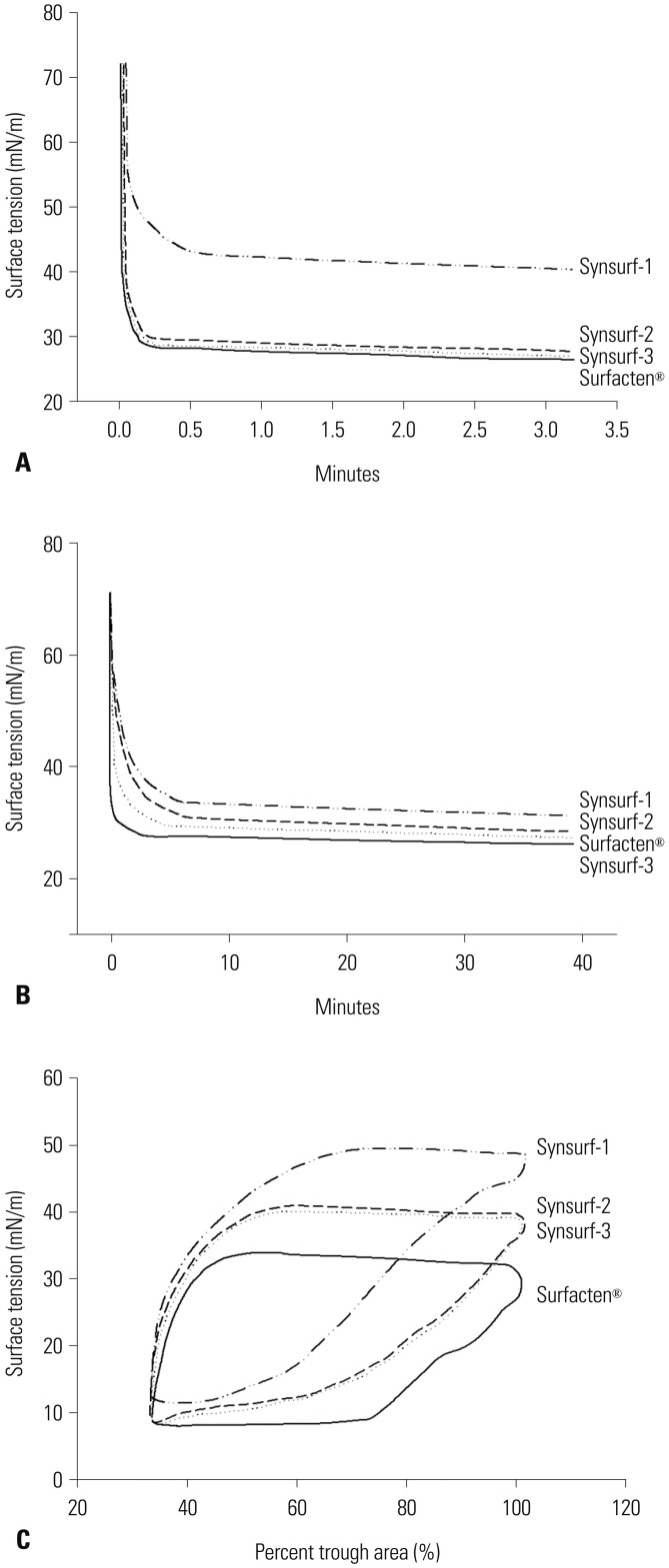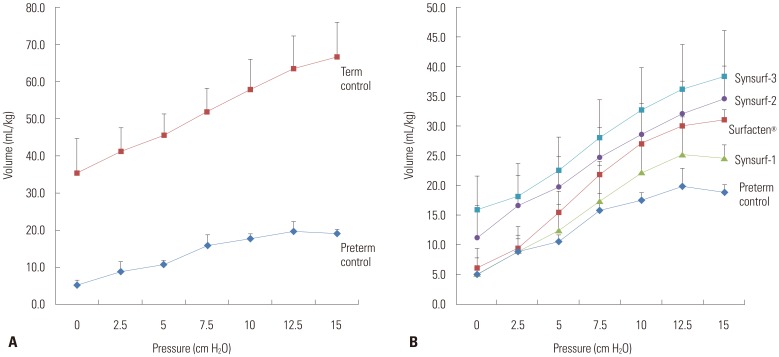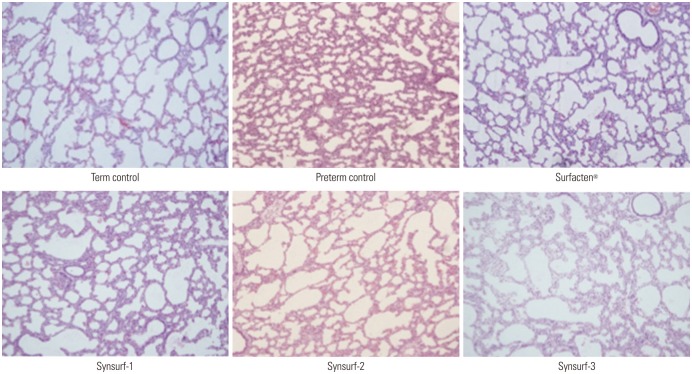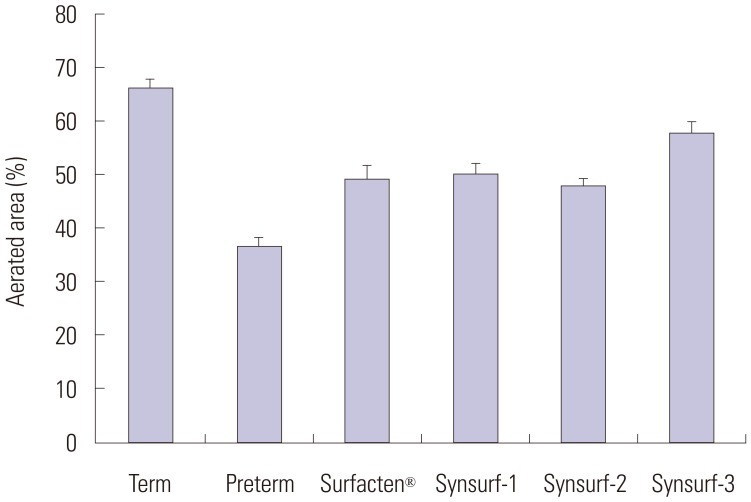1. Jobe AH, Hillman N, Polglase G, Kramer BW, Kallapur S, Pillow J. Injury and inflammation from resuscitation of the preterm infant. Neonatology. 2008; 94:190–196. PMID:
18832854.

2. Miedema M, de Jongh FH, Frerichs I, van Veenendaal MB, van Kaam AH. Changes in lung volume and ventilation during surfactant treatment in ventilated preterm infants. Am J Respir Crit Care Med. 2011; 184:100–105. PMID:
21493733.

3. Fujiwara T, Maeta H, Chida S, Morita T, Watabe Y, Abe T. Artificial surfactant therapy in hyaline-membrane disease. Lancet. 1980; 1:55–59. PMID:
6101413.

4. Soll R, Ozek E. Multiple versus single doses of exogenous surfactant for the prevention or treatment of neonatal respiratory distress syndrome. Cochrane Database Syst Rev. 2009; (1):CD000141. PMID:
19160177.

5. Kim SM, Park YJ, Chung SH, Choi YS, Kim CH, Bae CW. Early prophylactic versus late selective use of surfactant for respiratory distress syndrome in very preterm infants: a collaborative study of 53 multi-center trials in Korea. J Korean Med Sci. 2014; 29:1126–1131. PMID:
25120324.

6. Zhu Y, Miller TL, Chidekel A, Shaffer TH. KL4-surfactant (Lucinactant) protects human airway epithelium from hyperoxia. Pediatr Res. 2008; 64:154–158. PMID:
18391844.

7. Moya F, Sinha S, Gadzinowski J, D'Agostino R, Segal R, Guardia C, et al. One-year follow-up of very preterm infants who received lucinactant for prevention of respiratory distress syndrome: results from 2 multicenter randomized, controlled trials. Pediatrics. 2007; 119:e1361–e1370. PMID:
17533176.

8. Lu KW, Taeusch HW. Combined effects of polymers and KL(4) peptide on surface activity of pulmonary surfactant lipids. Biochim Biophys Acta. 2010; 1798:1129–1134. PMID:
20188696.

9. Soll RF, Blanco F. Natural surfactant extract versus synthetic surfactant for neonatal respiratory distress syndrome. Cochrane Database Syst Rev. 2001; (2):CD000144. PMID:
11405951.

10. Kallberg Y, Gustafsson M, Persson B, Thyberg J, Johansson J. Prediction of amyloid fibril-forming proteins. J Biol Chem. 2001; 276:12945–12950. PMID:
11134035.

11. Robertson B, van Golde LMG. Pulmonary surfactant: from molecular biology to clinical practice. Amsterdam: Elsevier Science Publishers;1992. p. 561–592.
12. Moya F. Synthetic surfactants: where are we? Evidence from randomized, controlled clinical trials. J Perinatol. 2009; 29(Suppl 2):S23–S28. PMID:
19399006.

13. Seger N, Soll R. Animal derived surfactant extract for treatment of respiratory distress syndrome. Cochrane Database Syst Rev. 2009; (2):CD007836. PMID:
19370695.

14. Walther FJ, Waring AJ, Sherman MA, Zasadzinski JA, Gordon LM. Hydrophobic surfactant proteins and their analogues. Neonatology. 2007; 91:303–310. PMID:
17575474.

15. Otsubo E, Takei T, Nomura M. Synthesis, purification and surface activities of the human pulmonary surfactant protein-C (SP-C) analogue, SP-CL16 (6-28). Biol Pharm Bull. 2001; 24:1362–1365. PMID:
11767102.
16. Bae CW, Chung SH, Choi YS. Development of a synthetic surfactant using a surfactant protein-C peptide analog: in vitro studies of surface physical properties. Yonsei Med J. 2016; 57:203–208. PMID:
26632402.

17. Otsubo E, Takei T. Effects of the human pulmonary surfactant protein-C (SP-C), SP-CL16 (6-28) on surface activities of surfactants with various phospholipids. Biol Pharm Bull. 2002; 25:1303–1306. PMID:
12392083.
18. Johansson J. Membrane properties and amyloid fibril formation of lung surfactant protein C. Biochem Soc Trans. 2001; 29(Pt 4):601–606. PMID:
11498036.

19. Almlén A, Walther FJ, Waring AJ, Robertson B, Johansson J, Curstedt T. Synthetic surfactant based on analogues of SP-B and SP-C is superior to single-peptide surfactants in ventilated premature rabbits. Neonatology. 2010; 98:91–99. PMID:
20110733.

20. Seehase M, Collins JJ, Kuypers E, Jellema RK, Ophelders DR, Ospina OL, et al. New surfactant with SP-B and C analogs gives survival benefit after inactivation in preterm lambs. PLoS One. 2012; 7:e47631. PMID:
23091635.

21. Bae CW, Choi YM, Kang JH, Lee SC, Kim KL, Hahm KS. A study of surface physical properties of new surfactant using synthetic peptides of surfactant protein-B. Korean J Pediatr. 2000; 43:1059–1067.
22. Nogee LM, de Mello DE, Dehner LP, Colten HR. Brief report: deficiency of pulmonary surfactant protein B in congenital alveolar proteinosis. N Engl J Med. 1993; 328:406–410. PMID:
8421459.












 PDF
PDF ePub
ePub Citation
Citation Print
Print


 XML Download
XML Download